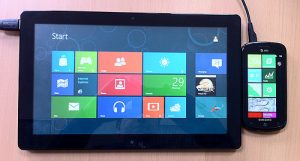
The prospect of rolling out a new operating system at work always feels a bit daunting, not least because of notorious issues with previous Microsoft Windows upgrades like Vista. It’s always important, therefore, to be as clued-up as possible about what the implementation of a new system will involve, and how you can expect life in the workplace to change once it is up and running.
Firstly, it’s worth noting that apart from the new-tech hype, Windows 8 promises to contain all those other elements you would normally expect from a system upgrade: greater speed, greater stability, and increased security. The actual changeover itself also looks like it will be a fairly undemanding process. Windows 8 Installer comprises a number of tools that aim to do as much of the work for you as possible: a hardware scanner that assesses whether your computer meets the minimum specifications for running Windows 8 and also offers configuration guidance; a software scanner that checks and offers advice on the compatibility of all pre-installed software; and a tool that specifically assesses line-of-business applications.
But, with a change in operating system there will inevitably be a short-term dip in workplace productivity, as users adjust to unfamiliar territory. When considering a system upgrade, also make sure that you assess the potential long-term effects and prepare your users accordingly. Think about the ways you can expect Windows 8 to permanently alter the working lifestyle of the people in your company.
In terms of actual operation, the key feature of Windows 8 is its new start screen with customisable tiles that offer easy access to the applications you use most. These tiles are continuously updated, so relevant social media and email updates are immediately visible and easily monitored. For forward-thinking businesses that have embraced the increasing usage of social media, this aspect will definitely be convenient, particularly in marketing departments.
Of course the most revolutionary feature of Windows 8, however, is that the operating system is designed to be experienced throughout your computing universe: on your tablet, your notebook, phone, and your PC. Significantly, Windows 8 is a unifying OS that promises to overcome the traditional separation between Home and Business editions of software – it was designed with multipurpose use in mind.
The largest long-term benefit for businesses is that employees may therefore have greater exposure to Windows 8, leading to higher levels of productivity overall. It is even possible that greater familiarity with the system will mean fewer user complaints to company IT ‘help desks’. In fact, as employees increasingly continue to use their own computing devices for work purposes, companies may not need to channel large resources into IT as a whole, at all.

